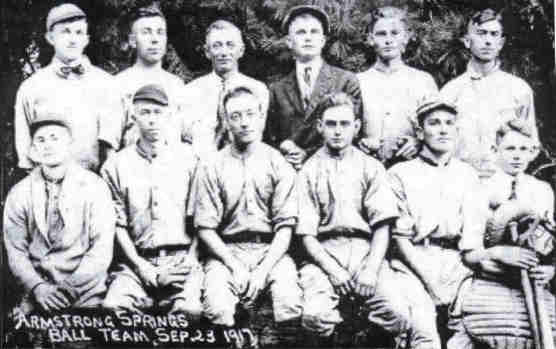The Killough brothers, Roe, Tommy and Willis were on the Armstrong
Springs community baseball team in 1917. The communities they played with were about 50-60 miles northeast of
Little Rock, Ark., in the vicinity of Searcy, Ark. Eual Boyles, writer of this article printed in Little Red
River Journal, June 13, 1984, was not on the same team but he lived near them at that time and his experiences were
likely the same as the Killough boys’ experiences. These brothers were three of the nine children of Thomas and
Margaret Killough, all born at the family farm southwest of Searcy near Des Arc Creek.
BASEBALL IN THE GOOD OLD DAYS
Many years ago around the turn of the century the people of Pangburn were interested in baseball. The balls and bats were homemade and the only person who had a mitt was the catcher. All the other players played barehanded. They played Shirley, Edgemont and the other small outlying towns. I assume they either walked, rode horseback or went in wagons.
In one of the games my father was pitching and a line drive from the hitter hit him on the shin and put him to bed for a long time. His friends and neighbors worked his crop for him during his illness. He never completely recovered from this wound and even in later life had to bandage his leg since his let continued to drain throughout his lifetime.
We were living in Augusta when I reached the age to play American Legion ball. Since I was the only person at home old enough to work I was desperately needed to help make the crop. When I asked Pop if I could play ball that year he came up with a solution. “Claude,” he said, “if you’ll get a day’s work done by noon on Thursday you can play ball Thursday afternoon.” Sunday was no problem since we never worked on that day. My nickname was Claude since there was a young man by that name in Pangburn. His daddy used to tell him, “Claude, I’ll whip you.” And his reply was, “Now, Pa, you won’t.”
On Thursday morning I caught and harnessed the team and I was waiting at the end of the rows to start plowing as soon as it was daylight. Pop relieved me for breakfast and by 11:30 I had a day’s work done.
We lived about six miles from town and I could usually hitch a ride into town and be ready to play ball with the Augusta team that afternoon. We played against Bald Knob, Batesville, Pangburn and Newport and the other teams that you’re familiar with.
Sometimes the games lasted until late in the afternoon and it would be dark by the time we got back to Augusta. If no ride was available I walked the six miles home and got up at 4:30 the next morning to go to work.
Mr. Segal was our manager and he loved and knew his baseball. It was reported that he had been a “utility” player with the St. Louis Cardinals in his young days.
During my first game played at Batesville, while playing the outfield with my Sears Roebuck
first base glove, I dropped the first fly that came my way. I was disgusted because I could have put that ball
in my hip pocket. His comment to me was, “Eual, don’t worry about it. There will be other balls to catch.
Catch ‘em.”

The Armstrong Springs community baseball team poses for a formal photo (note neckties on those who are not in uniform) on September 23, 1917. They are (from left): Front row—Roe Killough, Ralph Jarrett, Gus Kitts, Tommy Killough, Sam Sowell and Willis Killough; Back row—Jewell Lytle, W. E. Baker, Paul Jarrett, Walter Lytle, Roy Canfield and Noel Woodson.